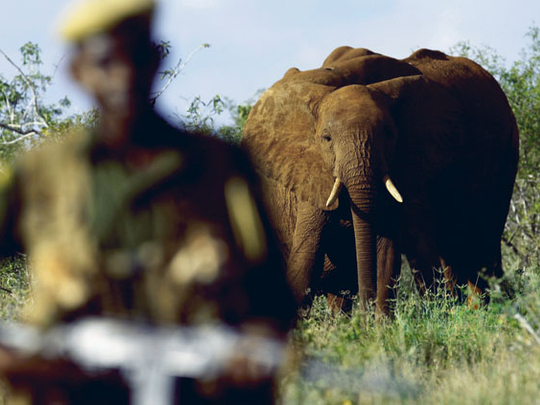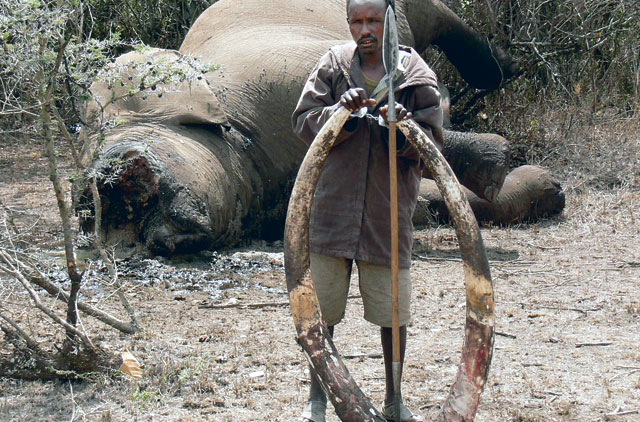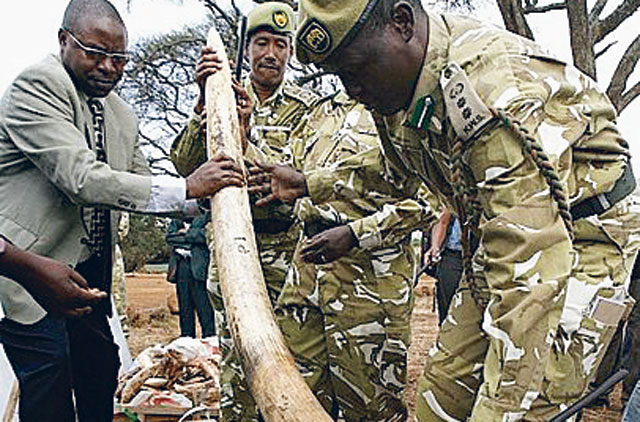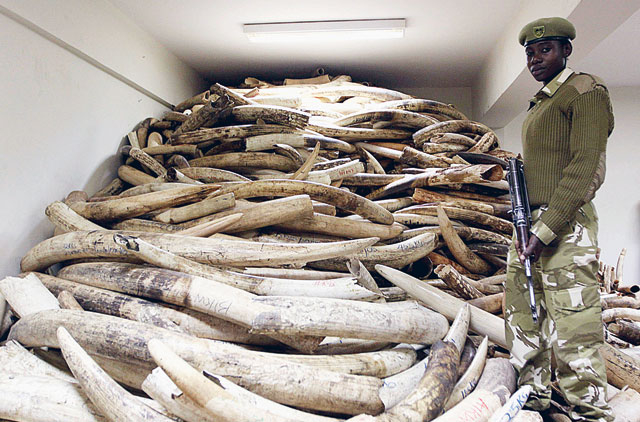
Jolson Kitheka had been on patrol for just a couple of hours when he saw his first dead elephant. He was out scanning every tree trunk or bush for snares, the lethal metal traps used by poachers to catch, maim and kill their prey. Yet about 200 yards ahead, partly obscured by trees on Kenya's vast Tsavo West national park, lay the unmistakable grey bulk of an elephant on the ground. Walking towards the giant creature, his worst fears were confirmed: It had been killed by poachers firing poisoned arrows. The tusks were crudely hacked off, along with the trunk.
"It was the work of professional poachers," Kitheka says, flinching. "They had sawn into its head to cut out the tusks from the root. The trunk and most of his face had gone. I could see the gaps where the tusks had been. The blood had clotted, liquid seeping out. I felt sick."
His experience has become an alarmingly common one of late. Twenty-one years after a worldwide ban was imposed on ivory trade, elephant poaching is on the rise all over Africa. The elephant Kitheka found was one of 220 killed by poachers in Kenya last year, up 400 per cent on the 46 killed just two years earlier.
Yet Kenya is a country with some of the best wildlife protection and enforcement in Africa. Things are much worse in countries cursed by poor security, corruption and civil war, where animal protection is a low priority. United States conservationists estimate that 36,000 elephants were poached last year. Sierra Leone says it lost its last few elephants in November, leaving Africa with 36 rather than 37 elephant range states. Elephant populations in Senegal, Mali and Niger are on the brink of extinction. Chad has just over 600 elephants left, more than 80 per cent down from the 3,800 it had in 2006, while Zimbabwe lost more than 3,000 elephants last year, according to conservationists.
In the war-torn Democratic Republic of Congo, militias sell ivory to buy weapons. "Elephants are being killed all over Africa," says Ian Redmond, a British wildlife biologist and elephant expert. "The ivory trade is rampant."
Ninety miles northeast of the Kenyan capital, Nairobi, a baby elephant hobbles slowly towards a water hole on the slopes of Mount Kenya. Its rear leg is caught in a snare which it drags around with it. The snare has torn open the elephant's flesh which has become infected. Unable to keep up with the herd, the elephant has been abandoned and without help will soon die of its wounds. The elephant was not a target of ivory poachers (it has no tusks) but was caught in a snare placed in the forest by another breed of poacher who is back in serious business. This is the "bushmeat" poacher, who kills animals for their meat.
Some are after "one for the pot", an occasional killing to put food on the table of their impoverished families. But bushmeat is big business. Gangs of poachers are wiping out wildlife on an industrial scale and selling thousands of tonnes of bushmeat to traders in Nairobi and other big cities in Kenya and other countries. Some is smuggled to Western Europe and the US.
Every creature, from giraffes and gorillas to buffaloes and antelopes, is the bushmeat poacher's prey. In some countries, such as the Central African Republic and Congo, elephants are skinned in situ and the killers cut out large quantities of meat to be sold in street markets. Soldiers in Zimbabwe have reportedly been given elephant meat as a cheaper alternative to beef in their rations.
The bushmeat poacher's favourite weapon is the snare, a simple but deadly metal loop placed on the ground and attached to a bush or tree. When an animal steps into the snare and tries to move away, the loop tightens around the bottom of its leg and cuts deep into the flesh, crippling and eventually killing the victim. For giraffes the snare is placed higher in the tree so that the head goes into the loop which then strangles the animal and slices its neck, causing an agonising death.
I join a newly formed anti-poaching team, part-funded by the Born Free Foundation and Land Rover, on patrol in the Mount Kenya National Park, a 885-square-kilometre Unesco World Heritage site. The area used to be teeming with wildlife; but no more. There are elephants here but the dense jungle, hilly terrain and tight security is enough to deter elephant poachers. The bushmeat poachers and their snares, however, are busier than ever.
"Snares are terrible things," says Edwin Kinyanjni, 29, the leader of the Born Free scouts, as he cuts a path through the thick jungle. "They are simple pieces of metal but they are indiscriminate and they can wound or kill any animal." Within minutes of starting the patrol, the team spots three would-be poachers. They run away but the rangers give chase. Fortunately the men are not armed and they are soon caught without much of a struggle.
"Sometimes they try to fight us," Kinyanjni says. "They use guns and spears and can be dangerous. So we have to be careful." The poachers are bundled into the back of a Land Rover and taken to the local police station but the patrol team says they will probably be given a fine too small to deter them from trying again.
As we trudge through the mountain forest we find scores of snares. "The poachers replace the snares as fast as we can remove them," Kinyanjni says. The Born Free team consists of four wardens who work with two armed rangers from the Kenya Wildlife Service with powers of arrest. They often stay in the forest for several days, camping out and waiting for the poachers to return to inspect the snares to see what they have caught. The forest can be unpredictable. We are on a day patrol but are almost forced to spend a night among the wildlife after we come across a herd of elephants and have to change our route.
We are soon lost in the dense forest nightfall and it takes the anti-poaching team three hours to find a way out. The next day, I join another patrol at the Ngong Forest sanctuary, about 16 kilometres from central Nairobi and here, closer to the city markets, we find more snares. The team found 291 snares in one three-day blitz of the forest. The smallest number they have found in one day is 58. Little wonder then that Susie Weekes, the executive officer of the Mount Kenya Trust, says: "The bushmeat trade is out of control."
It is a view echoed by Dame Daphne Sheldrick, who runs the David Sheldrick Wildlife Trust and whose lifelong conservation work includes running anti-poaching teams in national parks and an orphanage for baby elephants in Nairobi. "We know from our own experience that thousands of animals are being killed for the bushmeat trade and more resources are needed to tackle it," she says at her home near the orphanage.
The poachers are not small-time operators. Most elephants are slaughtered by organised gangs who ship huge quantities of ivory to lucrative markets in Asia, including Japan and particularly China, where it is used to make jewellery, carvings, chess sets, chopsticks and personal seals. Poachers are also ruthless and violent criminals prepared to kill those who try to stop their lucrative trade. More than 20 rangers have been killed in Kenya alone since 1990, the year after the ivory ban was introduced.
The increase in poaching is reflected in a record number of ivory seizures. There were more than 2,000 hauls between 2007 and 2009, according to the Elephant Trade Information System. Most of the ivory is on its way to China. Recently, customs officers in Thailand seized a record two tonnes of China-bound ivory — 239 tusks — in crates labelled "mobile phone parts". Some of the more spectacular hauls last year included nearly 10 tonnes in two seizures in Vietnam; 3.3 tonnes in the Philippines; and three quarters of a tonne in Kenya.
"These are enormous quantities of ivory," Redmond says. "That's a lot of slaughtered elephants."
Yet it seems not long ago that the African elephant had been saved. The horrific elephant poaching in the "ivory wars" of the Eighties more than halved Africa's elephant population, from 1.3 million in 1979 to just over 600,000 in 1989. This provoked worldwide outrage and prompted a campaign to save one of the world's most complex, intelligent and loved animals.
The result was a decision by the Convention on International Trade in Endangered Species (Cites) in 1989 to impose a complete ban on ivory sales. Conservationists rejoiced. Some elephant populations gradually started to grow again. So why has the killing started once more?
In truth, the ban reduced poaching but never stopped it. There are now fewer than 500,000 elephants left, more than 100,000 down on the number in 1989. In the best conditions elephant populations can grow by 5 per cent a year. Wildlife experts say the increase in killings is no mystery. They blame it squarely on a decision taken by Cites in 2007 to allow four countries to sell 105 tonnes of "stockpiled" ivory — tusks confiscated from poachers and removed from elephants who have died naturally — in what they described as a "one-off" sale.
To the horror of conservationists, many countries — including Britain — argued that the sale would satisfy demand and reduce poaching. In fact, it has had the opposite effect and led to a surge in elephant slaughter by poachers who launder their ivory through the legal trade.
The decision to allow the sale led to China and Japan being approved as trade partners and demand for ivory has soared. Last year, China approved 37 new retail ivory stores. Increased demand has pushed up the price.
A kilogram of ivory now fetches $40 in Kenya but up to $1,500 in the Far East, according to some conservationists. A small pair of tusks might weigh 10 kilograms — enough to bring a Kenyan poacher $400, more than casual workers earn in a year, while a big bull carrying 100 kilograms of ivory would bring in up to $150,000 in China. The first post-ivory ban sale, the first to be called a "one-off", was agreed by Cites at its meeting in Harare in 1997 under the auspices of President Robert Mugabe.
Worsening the situation
The Cites decision in 2007 for a second "one-off" sale, "sent out a signal to the world that ivory was available and legal", according to Will Travers, the chief executive of the Born Free Foundation who has attended every Cites meeting since 1989. "The poachers knew this was a great opportunity for them." Now, incredibly, the situation may be about to get even worse.
The Cites meeting in Doha, Qatar, recently, turned down Zambia and Tanzania's proposal that they should be allowed to "downlist" their elephants' protected status from Appendix 1 to Appendix 2, so that they could sell 110 tonnes of stockpiled ivory.
"There are fewer elephants alive today than when the ban was brought in, so it is beyond belief that anybody would want to weaken the ban. If you can't launder illegal ivory through the legal ivory trade then why would you bother?" Redmond says. "In an ideal world we could take ivory from natural deaths and carve it into beautiful objects. But as long as there are young men with guns and no job and dealers who say they have a market, and ask the young men to get them ivory, then elephants will not be safe unless they are heavily protected. And the cost of protection from illegal hunters and traders is much more than you can earn from the ivory trade." The only answer, he says, is "a total ban on ivory sales".
China has long been the biggest market for ivory but there is growing evidence — and concern — that the Chinese are heavily involved in elephant poaching in Africa. They have moved into Africa on a huge scale in recent years, building roads and other infrastructure in return for minerals and timber needed to fuel their domestic boom. Thousands of Chinese have left their homes to work on these huge projects worth billions of pounds.
"The Chinese are buying up ivory, worked and raw, all over Africa," says Esmond Bradley Martin, a leading ivory trade expert. The Chinese government denies any links between increased ele-phant killings in Kenya and the influx of Chinese workers and says it is fighting to stop ivory smuggling. Officials say that ivory seizures by Chinese customs officials have almost doubled in recent years.
At just one airport, Baiyun airport in Guangzhou, southern China, customs officers had dealt with 138 cases of ivory smuggling, totalling more than 182 kilograms, in the 12 months to August last year, up 90 per cent year on year. Under new Chinese laws, smugglers can be punished with up to 12 years in jail. Critics insist, however, that these hauls are the "tip of the iceberg" and maintain that criminal gangs in China are placing ivory orders with Chinese in Africa who hire local poachers and arrange for the tusks to be smuggled to China by sea or by air.
"When you have so many Chinese in Africa, and China allowed to buy ivory, it is easy to understand how the Chinese can become middlemen in the wildlife product broking system," Will Travers says. He says the Chinese government should put money into conservation and environmental protection to counter "what could be the fallout" of their presence in Africa. The US and the European Union also need to do more, he says.
At the headquarters of the Kenya Wildlife Service in Nairobi, Julius Kipng'etich, the service's director, sits back in his chair. "Poaching has risen in areas where the Chinese are building roads," he says. "Is that a coincidence? Ninety per cent of the ivory confiscated at Nairobi airport is in Chinese luggage. Some Chinese say we are being racist but our sniffer dogs are not racist."
The poachers are part of a "sophisticated network", he says. Many are switching from guns to poison arrows because arrows kill silently. Kipng'etich tells me of a new weapon in the poachers' armoury: planks of wood with poison-tipped nails sticking out of them. They are placed in the undergrowth and when the elephants walk onto them, they suffer excruciating pain and are eventually killed by the poison. "The poachers are cruel and clever but we are more determined than ever to tackle them," he says. "We cannot afford to lose our animals. They are our heritage and our future."
Rangers against poachers
Tourism is Kenya's second biggest employer, providing work for up to 160,000 people and bringing in revenue of $1 billion. He rejects claims that some rangers have colluded with poachers and says he is proud of his team, pointing to a board on the wall with coloured markers showing where his officers are deployed. The rangers are armed and use helicopter patrols to catch the elephant-killers but he wants to see better intelligence and wider use of "community scouts".
Deep in the bowels of the building I am given a glimpse of the thousands of tusks confiscated and retrieved by the wildlife service; all sizes and all thicknesses stacked on shelf after shelf and kept locked in a vault behind thick steel doors. This stockpile is not for sale, says the director, who remembers the day in 1989 when the then President Daniel Arap Moi ceremonially and with great symbolism, lit a bonfire to burn tons of ivory to mark the trade ban.
A few miles outside Nairobi, at Jomo Kenyatta international airport, the luggage glides along on a carousel behind the check-in desks and away from passengers' eyes. A black Labrador-collie cross called Charles leaps on to the conveyor belt and moves quickly and excitedly from bag to bag. He stops at a small pink suitcase wrapped in cellophane and starts to rip it open with his teeth. Inside he finds a large elephant tusk and shakes it about triumphantly.
The sniffer dogs belong to the Kenya Wildlife Service Dogs Unit, set up 10 years ago with the help of the British Army. They are playing an increasingly important role in the fight against the illegal ivory trade. When the dogs identify ivory in luggage or in freight containers security officers move quickly to find and arrest the passengers or the container owners. Sometimes they catch the big players but often they find only the "mules" who are used to get the ivory out of the country.
But conservationists believe that, in many countries, officials are bribed to smooth the smugglers' way. The number of ivory seizures at Nairobi's airport rose to nearly 60 last year, almost all of them thanks to the sniffer dogs. In September, the Wildlife Service seized half a ton of ivory at Nairobi airport, the largest haul at the airport for many years.
"We are losing more elephants and finding more ivory since the ivory ban was lifted," says Corporal Frank Keshe, the head of the unit. He is in no doubt who is behind most of the illegal trade. "Ninety per cent of what we find is heading for China. The Chinese have no restrictions on buying ivory, they are doing business in this country and they have ivory factories over there. You don't have to be a genius."
Kitheka is haunted by one detail of his encounter with the poachers' handiwork. The body he found was strewn with mud, leaves and twigs, tossed there by other elephants who had tried to cover up their friend; this is how elephants mourn their dead.





